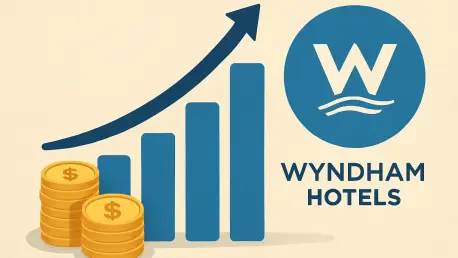In a world where travel shapes economies, how does a hospitality giant like Wyndham Hotels & Resorts manage to expand its empire while facing shrinking revenues? Imagine this: a remarkable 21% surge in room openings globally, yet a 5% drop in revenue per available room (RevPAR) casts a shadow over this success, revealing a complex story of ambition and adversity in the hospitality sector that invites a deeper look into how an industry leader navigates turbulent economic waters.
Why Wyndham’s Story Resonates in Hospitality Today
The significance of Wyndham’s latest earnings report extends far beyond its own balance sheets. As a barometer for the global hospitality industry, the company’s results reflect broader challenges like economic uncertainty and evolving traveler behaviors. With key markets showing signs of softening demand, understanding Wyndham’s trajectory offers vital clues about the health of an industry still recalibrating after years of disruption. This story matters because it highlights the delicate balance between expansion and profitability in a landscape where neither is guaranteed.
Breaking Down the Numbers: A Tale of Two Realities
Delving into the specifics of the third quarter, Wyndham presents a duality of triumph and tribulation. The company celebrated a robust 21% increase in room openings alongside a 24% rise in new contracts, pushing its global pipeline to an impressive 257,000 rooms across nearly 2,200 hotels. This growth, with 70% targeting midscale-and-above segments, signals a strategic focus on higher-revenue opportunities, especially as 58% of the pipeline spans international markets.
Yet, the revenue picture tells a different story. A global RevPAR decline of 5% was driven by a similar drop in the U.S., where occupancy fell by 300 basis points and average daily rates by 200 basis points. Internationally, a 10% plunge in China and a 5% dip in Latin America compounded the challenges, though gains in Europe, Middle East, and Africa (EMEA) with 4% growth and Canada at 8% offered some relief. Financially, net income edged up to $105 million, and adjusted EBITDA grew 2% to $213 million, though rising costs for insurance and employee benefits tempered these gains.
Regional Disparities: Where Growth Shines and Struggles Linger
A closer look at regional dynamics reveals stark contrasts shaping Wyndham’s performance. In the U.S., while coastal states like Texas and Florida faltered, the Midwest emerged as a surprising stronghold with a 4% RevPAR increase in areas like Oklahoma and Michigan. This uneven domestic recovery underscores how localized economic factors and travel patterns can sway outcomes for a brand with deep national roots.
Internationally, the narrative diverges further. EMEA’s steady 4% RevPAR growth and Canada’s robust 8% uptick reflect pricing power and demand resilience, contrasting sharply with Asia Pacific’s downturn, particularly China’s 10% decline amid broader regional economic concerns. These disparities highlight the unpredictable nature of global hospitality, where success in one area often coincides with setbacks in another.
Leadership’s Take: Balancing Caution with Ambition
Insights from Wyndham’s top executives add depth to the earnings story. CEO Geoff Ballotti emphasized the need to support franchisees in resisting excessive discounting, particularly in lower-tier segments, to safeguard profitability amid competitive pressures. His focus on maintaining rates for leisure business reflects a pragmatic approach to capturing demand without sacrificing margins.
Meanwhile, CFO Michele Allen projected confidence in the company’s global outlook, declaring that no market is “off limits” for expansion. This bold stance, paired with a strategic pivot toward midscale-and-above segments—evidenced by 2% growth in the U.S. and 7% in EMEA—illustrates a calculated optimism. Their combined perspectives suggest a leadership team keenly aware of immediate hurdles yet committed to a long-term vision.
Strategic Moves: Guidance for Franchisees and Investors
For stakeholders tied to Wyndham’s ecosystem, the third-quarter results offer actionable lessons. Franchisees are encouraged to adopt targeted pricing strategies, heeding Ballotti’s advice against last-minute discounts that erode value, especially in leisure-driven markets. Building resilience through rate stability could prove critical in navigating ongoing demand fluctuations.
Investors, on the other hand, should weigh the company’s promising long-term indicators against near-term headwinds. With a steady rooms growth projection of 4-4.6% and a pipeline skewed toward higher-revenue segments, there’s potential for sustained upside. However, caution is warranted given a revised full-year outlook anticipating a 2-3% RevPAR decline, alongside monitoring regional bright spots like EMEA and the Midwest U.S. for emerging opportunities.
As the dust settles on Wyndham Hotels & Resorts’ third-quarter earnings, the hospitality giant stands at a pivotal moment, having achieved remarkable expansion while wrestling with revenue declines. Looking back, the intricate dance between growth and economic challenges defined their journey. Moving forward, stakeholders must focus on leveraging strategic insights—whether through disciplined pricing for franchisees or region-specific investments for shareholders—to turn obstacles into stepping stones. The path ahead demands adaptability, with an eye on global diversification and segment prioritization to ensure that growth ultimately outpaces the headwinds.









